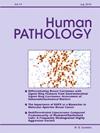Non-myxoid solid variant of extraskeletal myxoid chondrosarcoma: An underrecognized subtype
IF 2.7
2区 医学
Q2 PATHOLOGY
引用次数: 0
Abstract
Introduction
Extraskeletal myxoid chondrosarcoma (EMC) is a rare sarcoma defined by NR4A3 gene rearrangements, typically featuring uniform cells with eosinophilic cytoplasm and mild atypia, arranged in cords or clusters within a chondromyxoid stroma. A cellular variant, characterized by increased cellular density and a solid growth pattern, has been recognized.
Methods
We encountered three cases of round cell sarcomas, diagnosed as EMC based on NR4A3 or NR4A2 rearrangements. To identify additional pure solid EMC cases, we performed a retrospective review of our institutional files spanning 22 years, focusing on cases labeled as "myxoid chondrosarcoma" with "cellular" features. Histologic slides and clinical data were reviewed.
Results
In addition to the three study cases, 43 cases of EMC with cellular features were identified, none of which exhibited the exclusive round-to-spindle cell morphology seen in the study cases. The three unique cases involved two females and one male (ages 42–62) with tumors in the proximal extremities and trunk. The tumors (3.5–10 cm) were well-circumscribed and densely cellular. One tumor exhibited a biphasic pattern with distinct round and spindle cell areas, whereas the other two were composed purely of round/epithelioid cells. High-grade nuclear atypia and brisk mitotic activity (9–13 per 10 HPFs) were observed, with necrosis identified in one case. Next-generation sequencing revealed TCF12::NR4A3, EWSR1::NR4A3, and EWSR1::NR4A2 fusions. Two patients developed metastases (lymph nodes and lungs), whereas one remained disease-free at last follow-up.
Conclusion
We describe a round cell subtype of EMC, distinct from the traditional cellular variant, characterized by a sheet-like proliferation of large, uniform round-to-epithelioid cells and the absence of chondromyxoid stroma. This potentially underrecognized subtype requires molecular testing for accurate diagnosis. Moreover, the presence of NR4A2 fusions, although rare, suggests that the absence of NR4A3 rearrangements does not entirely exclude EMC.
骨外黏液样软骨肉瘤的非黏液样实体变体:一种未被充分认识的亚型。
骨外黏液样软骨肉瘤(EMC)是一种罕见的由NR4A3基因重排定义的肉瘤,典型特征为均匀的细胞,嗜酸性细胞质和轻度异型性,在软骨黏液样基质内呈索状或簇状排列。一种细胞变异,其特征是细胞密度增加和固体生长模式,已被确认。方法:根据NR4A3或NR4A2重排诊断为EMC的3例圆形细胞肉瘤。为了确定更多的纯实性EMC病例,我们对22年来的机构档案进行了回顾性审查,重点关注具有“细胞”特征的“粘液样软骨肉瘤”病例。我们回顾了组织学切片和临床资料。结果:除3例研究病例外,还鉴定出43例具有细胞特征的EMC,均未表现出研究病例中所见的独特的圆梭形细胞形态。这三个独特的病例包括两名女性和一名男性(42-62岁),肿瘤位于肢体近端和躯干。肿瘤(3.5 ~ 10cm)边界清楚,细胞密集。一个肿瘤表现为双相模式,有明显的圆形和梭形细胞区,而另外两个肿瘤则完全由圆形/上皮样细胞组成。观察到高级别核异型性和活跃的有丝分裂活性(9-13 / 10 hpf),其中一例发现坏死。下一代测序显示TCF12::NR4A3, EWSR1::NR4A3和EWSR1::NR4A2融合。两名患者发生了转移(淋巴结和肺),而在最后随访时,一名患者仍无疾病。结论:我们描述了EMC的圆形细胞亚型,与传统的细胞变体不同,其特征是大而均匀的圆形上皮样细胞的片状增殖和软骨粘液样基质的缺失。这种潜在的未被充分认识的亚型需要分子检测才能准确诊断。此外,NR4A2融合的存在虽然罕见,但表明NR4A3重排的缺失并不能完全排除EMC。
本文章由计算机程序翻译,如有差异,请以英文原文为准。
求助全文
约1分钟内获得全文
求助全文
来源期刊

Human pathology
医学-病理学
CiteScore
5.30
自引率
6.10%
发文量
206
审稿时长
21 days
期刊介绍:
Human Pathology is designed to bring information of clinicopathologic significance to human disease to the laboratory and clinical physician. It presents information drawn from morphologic and clinical laboratory studies with direct relevance to the understanding of human diseases. Papers published concern morphologic and clinicopathologic observations, reviews of diseases, analyses of problems in pathology, significant collections of case material and advances in concepts or techniques of value in the analysis and diagnosis of disease. Theoretical and experimental pathology and molecular biology pertinent to human disease are included. This critical journal is well illustrated with exceptional reproductions of photomicrographs and microscopic anatomy.
 求助内容:
求助内容: 应助结果提醒方式:
应助结果提醒方式:


